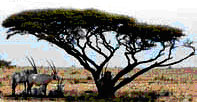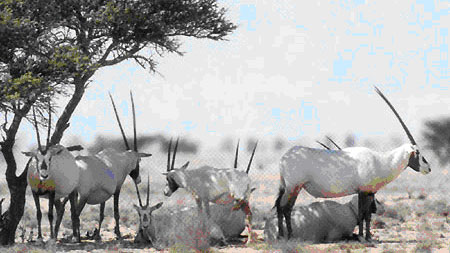The Arabian Oryx Project was established in 1979 by Royal Decree to protect the area which includes the Sahil al Jazr coastline of Central Oman. It aims to re-establish a free ranging population of the Arabian Oryx which had become extinct in the wild. The Sanctuary has an area of 27,500 sq. km within the Central Desert and Coastal Hills region of Oman. The project was begun with a captive herd from Oman’s Bait al Barakah Breeding Centers.
The Arabian Oryx are white, with black or brown lower limbs and dark patches on the face. The summer coat of the Oryx is short and sparse. The white coat aids in reflecting sunlight. Oryx calves are light brown. It is a grazing animal, and is able to walk great distances requiring little water.
The Sanctuary is the only wild breeding site in Arabia of the endangered houbara bustard, and a safe haven for the Nubian ibex, Arabian wolf, honey badger, caracal and a large population of Arabian gazelle .
Plant life in the Sanctuary consists of 250 different kinds of plants, eleven of which are found only in Oman. The plants survive on the small amount of rainfall and on moisture from fog which drifts off the Indian Ocean. The plants are grazed by the Oryx, goats and camels and are used by local people for shade and herbal medicines. The leaves of the dwarf palm are used for weaving.
Beyond Oman the only wild population of Oryx is found in the ‘Uruq Bani Ma’arid protected area in Saudi Arabia. This population was established in 1995 with the reintroduction of captive-bred animals from elsewhere in the Kingdom. The reserve covers 12,000 sq. km at the western edge of the Rub’al Khali or ‘Empty Quarter’. By March 1997 numbers in the wild had reached 100 and had doubled to approximately 200 by September 2001. A breeding program in Jordan hopes to re-introduce Oryx to Wadi Rum.
The Arabian Oryx Sanctuary is the region’s first UNESCO World Natural Heritage Site, inscribed in 1994.
photo source: www.oryxoman.com



